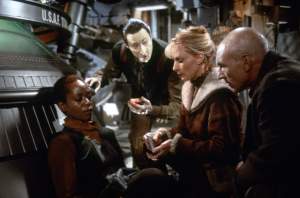Suicide Squad

Quaid1121/moviestillsdb
What a mess Suicide Squad is.
To be clear, we’re talking about the 2016 Suicide Squad, not the 2021 standalone sorta-sequel The Suicide Squad nor the 1953 firefighter action film Suicide Squad, both of which were quite good. Got it?
David Ayer’s film reeks of a project that was destroyed during post-production via committee. Rumors of multiple editors, massive reshoots, and disagreements over the rating and overall tone dogged the film for months before release. This was also something of a trend with DCU projects of the era.
One wonders if there’s a good version of this movie sitting on a hard drive somewhere.
Steel

PabloUltiMonster090/moviestillsdb
Long before the days of expanded universes and post-credit teases, Superhero films were just another flavor of action movie that you could insert a rising star into to see if audiences might bite. Steel, released in the summer of 1997, was the final attempt after Blue Chips and Kazaam to transform Shaquille O’Neal from a basketball phenom into a real-deal movie star.
It did not work.
The film feels more like a made-for-TV movie than it does a summer blockbuster. And it was all the proof we needed to confirm Shaq was not a Schwarzenegger. He is barely a Michael Jordan in Space Jam.
Moribus

meprdb/moviestillsdb
Morbius is the third film in Sony’s misguided, foolhardy attempt to have their own Spider-Man Universe separate from the MCU that doesn’t feature Spider-Man. In this one, we follow the misadventure of Morbius the living vampire played by everyone’s favorite ageless weirdo, Jared Leto. The film was dragged by critics and audiences alike and underperformed at the box office.
Meanwhile, the disingenuous catchphrase “It’s Morbin’ Time” began trending on social media a few months after its initial release. Sony, thinking this was some kind of grassroots movement to support the film, re-released it to 1000 theaters. It once again failed to perform. Whoops.
The Spirit

Flaying/moviestillsdb
The Spirit is an early comic book superhero created by the highly regarded and hugely influential cartoonist Will Eisner. For years Hollywood has looked to adapt it but nothing ever materialized. That is until 2006 when it was announced that famed graphic novelist Frank Miller would write and direct the film. Miller would use the same visual technique that he and co-director Robert Rodriguez used to great success in their big-screen version of Sin City.
Unfortunately, there was one big problem: Frank Miller. His script was incomprehensible, the visual style was a poor fit for the source material, and the final product was a lifeless, unwatchable mess.
Hopefully, someone will take another shot at adapting this legendary source material.
The League of Extraordinary Gentlemen

zayne/moviestillsdb
What’s sadder: that this was Sean Connery’s last live-action feature film, or that he only agreed to do it because he had previously turned down roles in The Matrix and The Lord of the Rings and was afraid he was missing the boat again?
Reimagining recognizable public domain literary characters as a team of Victorian-era superheroes is an excellent idea, and there’s a good movie to be made from the source material by Alan Moore and Kevin O’Neill, but unfortunately, this isn’t it. This is a rudderless narrative with a couple of poorly executed action scenes attached to it.
Green Lantern

mark strong/moviestillsdb
Once upon a time, Martin Campbell’s 2011 Green Lantern film was meant to be the kickoff project of an expanded DC Universe to compete with Marvel.
Then the movie came out.
In addition to a script that attempts to cram too much Lantern lore into its two-hour run-time and heavy use of visual effects that are less than convincing, the big problem is Ryan Reynolds’ innate unseriousness that drags the picture down. He works perfectly as Deadpool, but not as Hal Jordan.
The lone highlight is Peter Sarsgaard, who does his best to elevate the material and inject some pathos into his version of Hector Hammond.
Elektra

334kb/moviestillsdb
Whoever convinced Jennifer Garner to agree to this needs to send her a giant fruit basket and apologize. Garner is perfectly fine as the star of films like Ghosts of Girlfriends Past or 13 Going on 30. She was even serviceable playing this same character in Daredevil as she was in a supporting role. But as a leading woman in an action film? It simply does not play to her strengths as an actor.
That’s just one of several unforced errors around Elektra, the least of which is that this is a sequel to Daredevil that literally no one was asking for.
Howard The Duck

yodagale/moviestillsdb
Did you know that before this fowl comic book character was a duck-shaped easter egg in Marvel post-credit scenes, he was the star of his very own movie? It’s true.
Roundly considered one of the worst films ever made, Howard the Duck was released in the summer of 1986 and starred Lea Thompson and Tim Robbins. Adapting the satirical comic series was an idea that came from George Lucas, who first began thinking about the project following the release of American Graffiti.
The movie has a cult following today, though even as a “so bad it’s good” viewing experience you can do much better.
Superman IV: The Quest For Peace

glowworm/moviestillsdb
You have to feel for Christopher Reeve with this one, who likely agreed to don the cape one more time out of an interest in telling a story about nuclear disarmament and a misguided obligation to his fans.
Set aside the low-budget special effects or the stupidity of Lex Luthor’s Nuclear Man, the real sin of Superman IV is that it’s incredibly, miserably dull. If the tagline of the original Superman was “You’ll believe a man can fly” then the tagline for this one should have been “You’ll believe paint can dry.” Even the prior entry in the franchise, Supergirl, had some camp value. This has nothing to offer.
The Fantastic Four

darcy/moviestillsdb
What a mess Fantastic Four is.
To be clear, we’re talking about the 2015 Fantastic Four film, not the 2005 Fantastic Four directed by Tim Story nor the unreleased 1994 Fantastic Four movie produced by Roger Corman, both of which were also quite bad but not as bad as Josh Trank’s version. Got it?
This one makes the list over the others for two reasons: this production had so much more potential, and the version that was released in theaters is barely a movie. It’s like an extended first act to a movie we never get to see — the cinematic equivalent of watching an orchestra tune-up for 90 minutes and then frantically destroying their instruments for the next ten.







